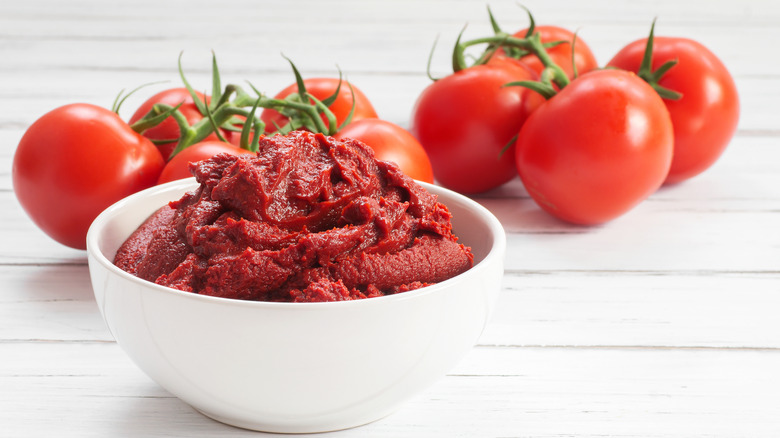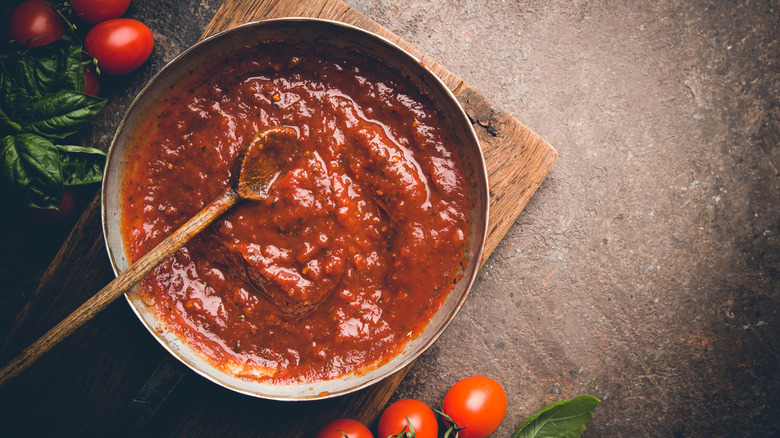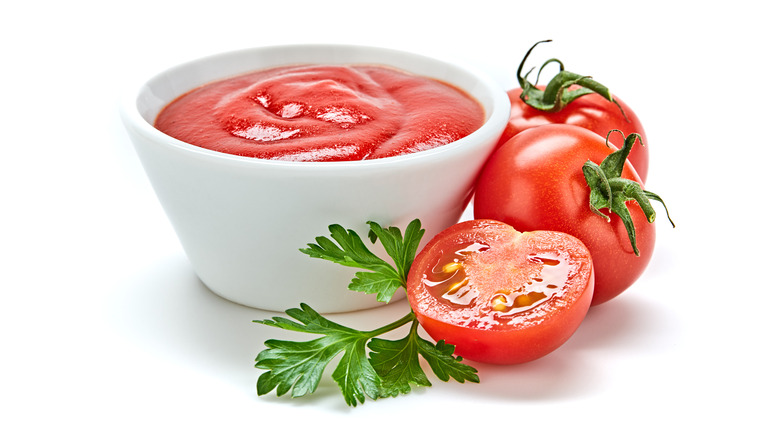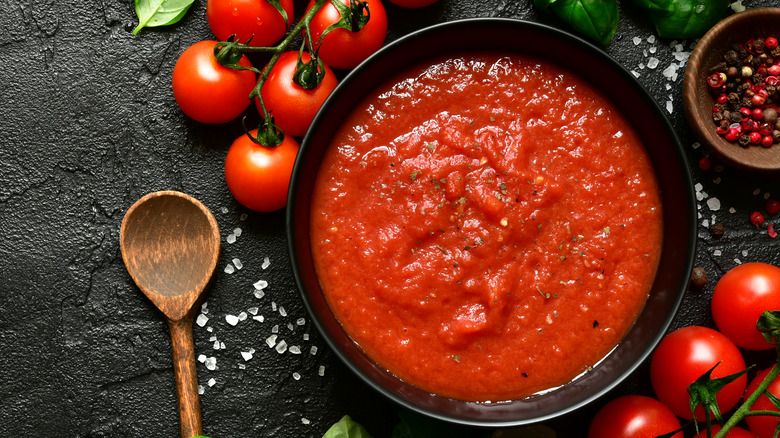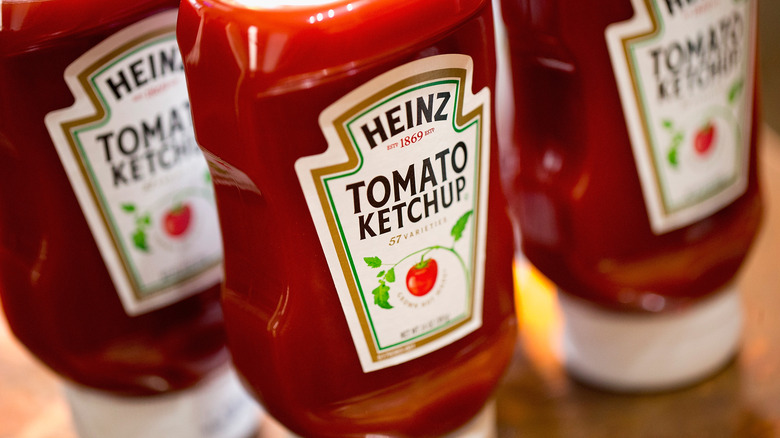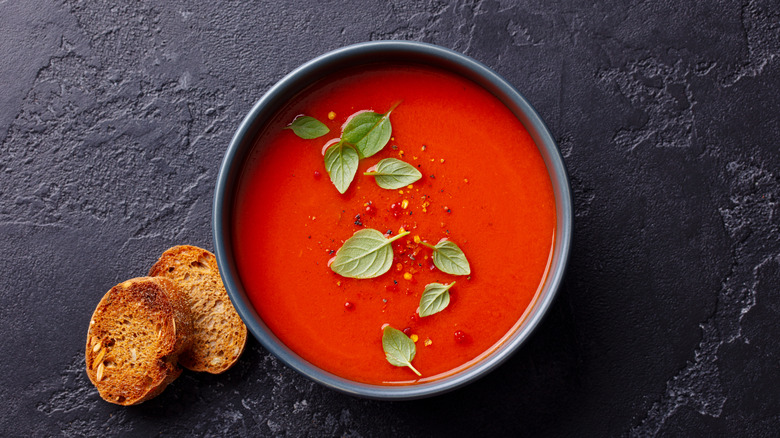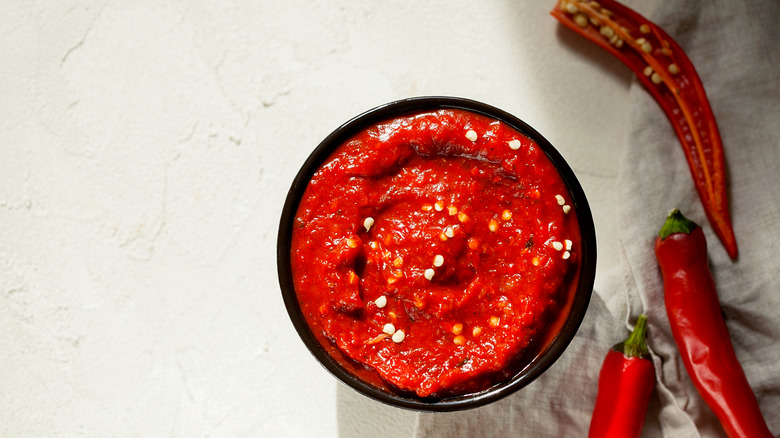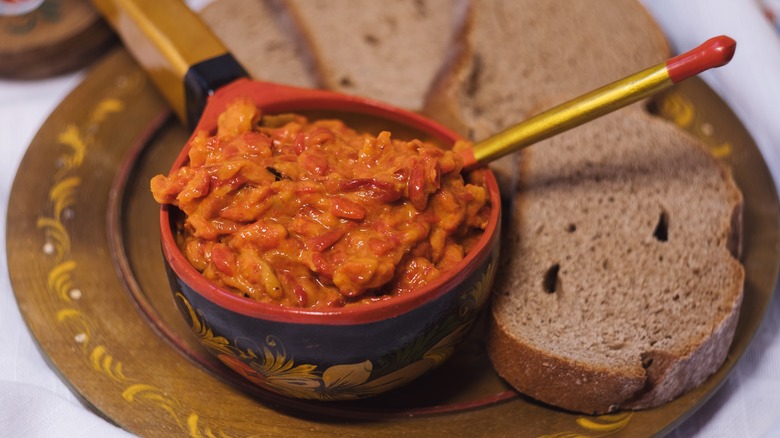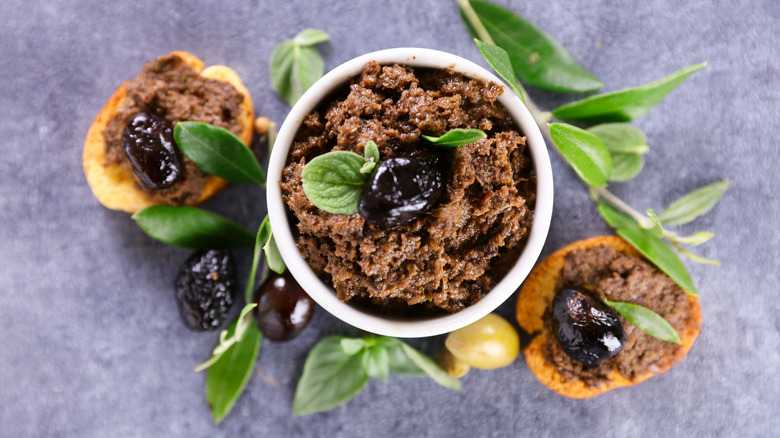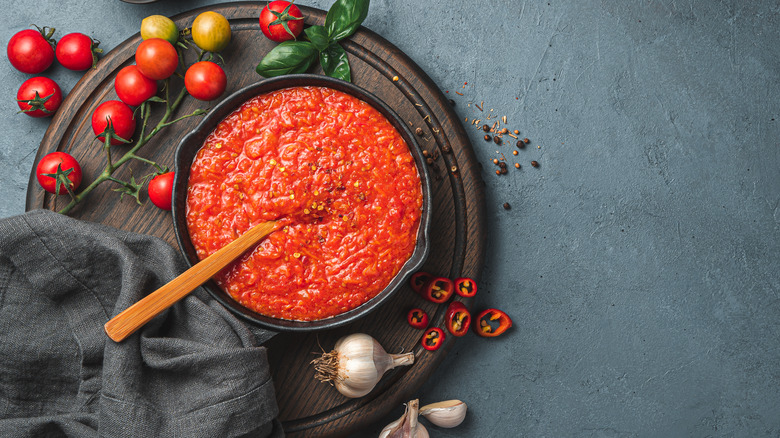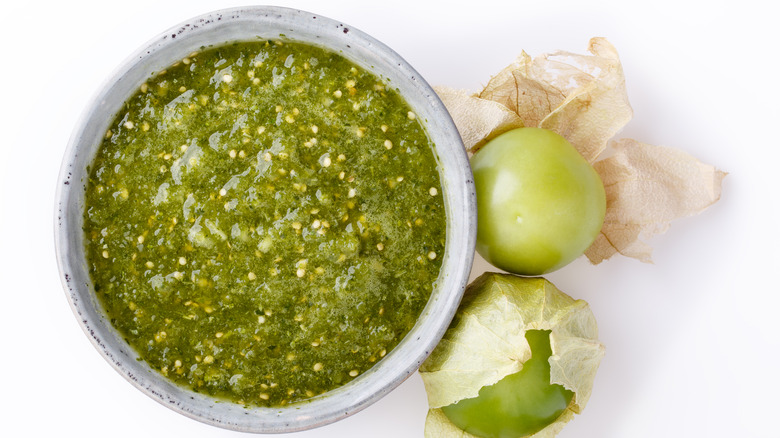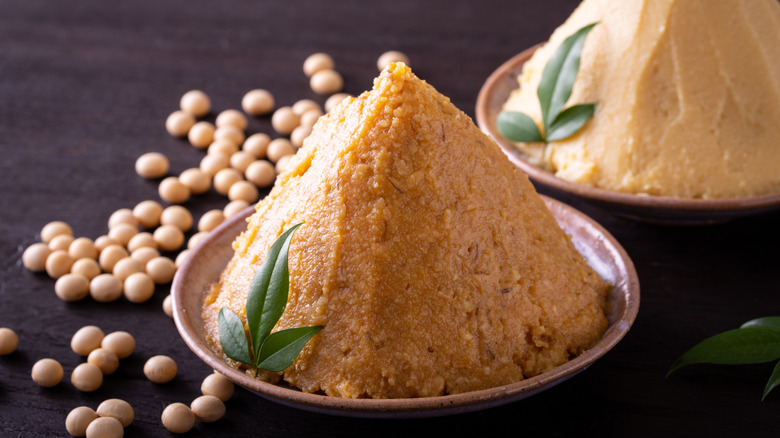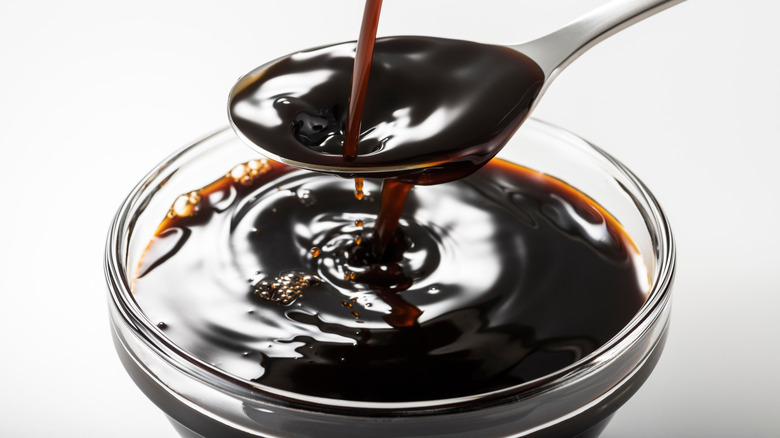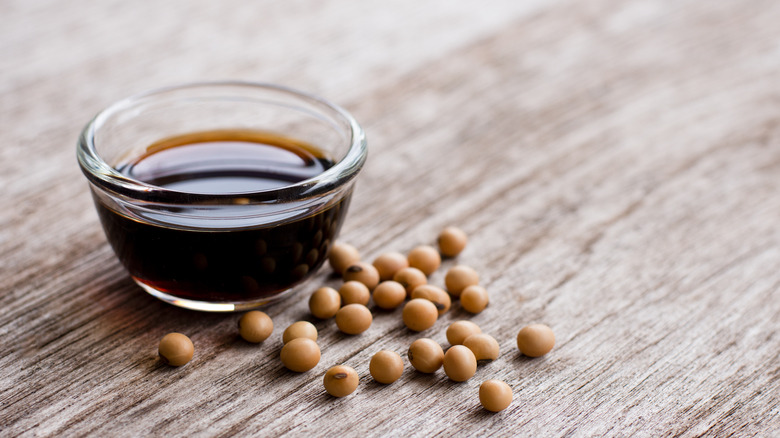The 14 Absolute Best Tomato Paste Substitutes
Realizing that you are one ingredient short while cooking is a real bummer. That's why it's always helpful to have some substitution alternatives. Tomato paste is one of those ingredients so full of flavor that it can make a dish pop. It belongs in various recipes because it blends the umami and sweet tastes that result from cooking tomatoes for a long time. Usually, tomato paste appears in soups, dips, pasta sauces, stews, and marinades. What would beef chili, paella, and Bolognese be without tomato paste?
Because tomato paste has a strong flavor, most recipes only require a slight amount, so it's best to buy it in small cans or jars. The good news is that there are ways to preserve and use leftover tomato paste so it won't go to waste. But what happens when you entirely run out of this versatile ingredient and your recipe calls for its unique flavor and texture? Here are 14 ways to substitute it in your dishes.
Tomato sauce
Some great substitutes for tomato paste are the widely available tomato-based products. The very first that comes to mind is tomato sauce. Tomato sauce is usually a product with sweet notes from added sugar. The difference between tomato sauce and tomato paste is in texture and flavor. The main ingredients in both are unsweetened crushed tomatoes. For tomato paste, these are reduced by boiling until they thicken. The technique produces a more robust, acidic flavor and a naturally sweet taste. The sauce is lighter and more liquid than the paste and often has additional flavors, such as garlic and basil, like in this heirloom tomato sauce recipe or this no-cook tomato sauce recipe.
Remember that the best sauces use tomato varieties that don't have much water, so the flavor is not diluted. If you substitute tomato paste with tomato sauce, you should double the quantity in the recipe, so use two tablespoons of tomato sauce for one tablespoon of tomato paste. Because you are doubling the quantity of a liquid ingredient, you should also even out the recipe and remove one tablespoon of another liquid element, so you don't end up with a mushy dish.
Tomato purée
Tomato purée is a product made with just one main ingredient, crushed tomatoes. It is thinner than tomato sauce and tomato paste. One difference between tomato sauce and tomato purée is that the purée has a different taste, as tomato sauce has many additional flavors. Also, the sauce has a creamier consistency than purée. To make tomato purée, blend some whole or crushed canned tomatoes and simmer them for a short time. Strain the resulting purée, as skins and seeds will affect the texture. Typically, the only ingredients added to tomato purée are salt and citric acid to help preserve the tomatoes. After opening a can of tomato purée, you should use it as soon as possible because it will spoil in a few days.
When using tomato purée to substitute tomato paste, add twice the amount. The only difference could result from consistency, but mixing the purée with the other ingredients (while halving the liquids) should resolve it. The taste of tomato purée is similar to that of tomato paste, so your dish will have the same level of acidity and sweetness. You can substitute tomato paste with purée to make a hearty mushroom sauce, stews, soups, and salads.
Tomato passata
Tomato passata is a true staple of Italian cooking. Lighter than tomato paste, passata is a tomato purée that has not been reduced by stewing. Passata appears in many recipes, either as such or as a tomato paste substitute. Unlike tomato purée, tomato passata uses only fresh tomatoes (not canned ones), so it comes with a burst of bright flavor. In addition, it takes less time to make than any other tomato product because it doesn't require stewing. For passata, tomatoes are juiced, deseeded, and then cooked. Passata is not usually flavored with other ingredients, although there are recipes that require adding garlic or basil. The typical passata taste is sweet and savory simultaneously, capturing the essence of tomato flavor.
To substitute tomato paste with passata, you should triple the required amount. For example, if the recipe asks for one tablespoon of tomato paste, you should use three tablespoons of tomato passata. If the additional liquid affects the texture of your dish, spend a few minutes simmering the passata before adding it to your recipe. That way, you will have a full-bodied taste and a creamier texture. With its fresh flavor and real tomato taste, passata can be an excellent addition to any dish based on the sweet acidity of tomatoes.
Canned tomatoes
Although fresh tomatoes bring the advantage of summer flavors, they are not the best choice for every dish. The differences of canned tomatoes are better for cooking because they react better under heat exposure. Because of their thicker texture, canned tomatoes are also a perfect substitute for tomato paste, making it possible to obtain the dish's consistency and characteristic flavor. Depending on the different types of canned tomatoes, it is possible to upgrade a recipe with certain flavors, such as the smoky quality of fire-roasted tomatoes.
However, as they are not as concentrated as the tomato paste, the substitution rate when using canned tomatoes instead of paste is two tablespoons of canned tomatoes for every tablespoon of tomato paste. Also, remember that canned tomatoes contain a lot of liquid, so you should strain them when substituting paste because you want an ingredient that resembles the original texture as closely as possible. The best options when replacing tomato paste with canned tomatoes are diced or stewed tomatoes, but fire-roasted and crushed tomatoes also work well. As a substitute, canned tomatoes work best in stews or spreads, but you can add them to your pasta sauce if you like a little texture.
Ketchup
Ketchup is a kid's favorite and an essential kitchen staple, suitable for many recipes but also terrific on its own. Nowadays, the fact that ketchup is tomato-based is obvious, but things were very different in the past. The first ketchup recipe was a Chinese sauce made from fermented fish sauce. As time passed and the sauce traveled outside China, it adapted to local ingredients and cuisines. And, until tomatoes became popular in the 19th century, it was made using all kinds of components, such as mushrooms (mushroom ketchup is still a thing) or walnuts. Often part of the untold truth of ketchup, the company Heinz is mostly responsible for why the condiment came to be associated with tomatoes.
Ketchup works excellently as a tomato paste substitute. It has a very similar, thick texture and a more complex taste because it contains more vegetables and spices. You can make your own ketchup using allspice, chilis, garlic, red wine vinegar, onions, peppercorns, and brown sugar. In recipes requiring tomato paste, ketchup can be substituted using a 1:1 ratio, which means one tablespoon of ketchup for every tablespoon of tomato paste. Keep in mind that ketchup tends to be a bit sweeter than tomato paste, as it has added sugar, which can affect the taste of your finished dish.
Tomato soup
Tomato soup is a hearty and healthy dish that is perfect for cold months and also packs many vitamins. As tomatoes offer abundant nourishing benefits, tomato soup also carries the nutrients that resist the high temperatures of cooking, such as vitamins C, K, A, and potassium (via Healthline). Rich in antioxidants, tomato soup sustains healthy skin and vision and improves bone health. You can make a flavored tomato soup using onions, garlic, bay leaves, cumin, chili pepper flakes, fire-roasted tomatoes, vegetable stock, and butter. You can also make a vegan tomato soup and use coconut milk and brown rice to thicken it.
As a tomato paste substitute, tomato soup brings almost the same taste (plus a hint of more sweetness) and a variable texture. However, because it contains more liquid, you should use tomato soup as a tomato paste substitute in recipes made with a lot of wet ingredients — such as other soups or sauces — so that your dishes don't turn out runny. If you substitute tomato paste with tomato soup, you should reduce the other liquid ingredients by ¼ to ½ cup.
Harissa
Harissa is a North African chili pepper paste with roasted red peppers, garlic, coriander, and caraway seeds. It is a representative ingredient in the region's cuisines, bringing a bit of heat and smoky flavor to any dish. This harissa recipe has flavors of cumin, cayenne pepper, Hungarian paprika, and caraway and, most important, uses the texture and sweet acidity of tomato paste. While harissa is a spicy Moroccan staple, it is also commonly used in many Middle-Eastern dishes, such as falafel, or in simple sandwiches that need a bit of a taste kick. Harissa is also great for bringing flavor and heat to simple dishes such as yogurt dips, marinades, scrambled eggs, noodles, or braises.
As far as texture is concerned, harissa is very similar to tomato paste, so that it can work as a substitute. It won't alter the consistency of the dish. However, the taste is different than tomato paste, as the main ingredients in harissa are peppers, which have a distinct flavor. Also, unlike tomato paste, harissa is hot; using it as a swap will bring a new dimension to your meal. If you substitute tomato paste with harissa in a recipe, you should use half of the required amount to preserve the texture without modifying the taste.
Ajvar
Ajvar is eaten in many Balkan countries, specifically in Serbian, Croatian, and Bulgarian cuisines. The dish is normally made as a traditional recipe, which means each family uses a specific ingredient combination when preparing it. The main ingredients are roasted red bell peppers, and the most basic recipe only adds hot peppers, salt, and vegetable oil. More complex ajvar recipes also incorporate roasted eggplant, vinegar, sugar, garlic, or tomatoes. Ajvar is prepared in the autumn when all the necessary vegetables are ripe. Preparing ajvar is usually a family event for several generations in the Balkans. The sauce can be consumed as a relish, vegetable sauce, or spread. Some ajvar recipes use more chilies to make these dish varieties spicier.
Ajvar has a similar consistency to tomato paste, preserving the recipe's texture when substituted. However, the taste is different, as ajvar primarily uses red bell peppers, not tomatoes. The taste packs the eggplant's creaminess, the vinegar's kick, and the smoky flavors of roasted vegetables. It is slightly acidic but less sweet than tomato paste. When you substitute tomato paste for ajvar, use a 1:1 ratio, bearing in mind that the dish will have a somewhat more vegetal flavor.
Olive tapenade
Tapenade is a Mediterranean spread made from olives, a dish full of salty and briny flavors. Perfect as a spread on fresh bread or toasted baguette slices, it can also work as a dip, sandwich spread, or substitute for pizza sauce. So, no wonder it also works as a tomato paste substitute if you're looking for a boost in flavor. With its complex, umami, and savory aromas, tapenade is a welcome addition to pasta sauce, mayonnaise, salads, eggs, or flavored butter. The main ingredients in tapenade are olives, but you can use all kinds of flavors to enhance the taste. This tapenade recipe combines the flavor of olives with horseradish mustard, garlic, thyme, and oregano. To add more umami, you can use capers or anchovies. It all depends on your preferences and what types of flavors you choose.
When you substitute olive tapenade for tomato paste in your recipes, your dish will taste differently. Tapenade lacks sweetness completely. However, it will enhance all the umami and savory notes and provide a similar texture because olive oil makes tapenade paste-like. A 1:1 ratio is appropriate if you like olives. If you're not a fan, start with a smaller tapenade amount and increase it gradually.
Marinara sauce
Marinara sauce is part of many Italian dishes that require light flavors and a thin texture. The purpose of marinara sauce is not to overpower the rest of the ingredients with the tomato flavor. The best example of a dish that uses the subtle taste of marinara sauce is pizza. Here, it aims to bind the ingredients together and add a fresh hint of tomato flavor. Marinara consists of whole peeled tomatoes, olive oil, garlic, and basil. This recipe for marinara sauce offers a fast version, ready in only 15 minutes. Aside from being a pizza ingredient, the sauce goes well with fried calamari, mozzarella sticks, and submarine sandwiches. Marinara sauce and tomato sauce are different as marinara is lighter and fresher. In contrast, tomato sauce has a more complex flavor (due to the many ingredients added to the tomatoes) and is sweeter because it has to simmer for approximately two hours.
When using marinara sauce to substitute tomato paste in a recipe, you should triple the required amount. So, for every tablespoon of tomato sauce needed, use three tablespoons of marinara sauce. Make sure you only use the marinara as a tomato sauce substitute in recipes that call for many wet ingredients because the sauce has a runnier texture. Also, remember that it has a light flavor, so don't mix it with something powerful, or you won't be able to taste it.
Salsa verde
Salsa is one of the most popular sauces in America, and still, its many qualities remain underappreciated because it always appears in the same combinations. Traditionally used for chips, tacos, and fajita, salsa can bring a lot of flavors and some heat to more dishes than is typically believed. There are many salsa varieties, each with varied characteristics and specific tastes. Salsa verde is the green salsa variety, which uses green tomatoes combined with other ingredients (usually the same color), such as avocado, jalapeno, or cilantro. This recipe for creamy salsa verde owes its silkiness solely to avocado and is made only with raw ingredients. Meanwhile, in this tomatillo salsa verde recipe, the tomatillos and jalapenos are broiled for ten minutes before you chop and mix each with the other ingredients.
Because of the strong tomato flavor and creamy texture, salsa verde works very well as a tomato paste substitute. Use salsa verde as a tomato paste substitute only in recipes where the green color is not very important. When substituting, use salsa verde in a 1:1 ratio. Although it is creamy, salsa verde doesn't have the same consistency as tomato paste, as it's less thick, so you should adjust the other liquids to obtain the same thickness.
Miso paste
A traditional Japanese seasoning, miso is a paste made from fermenting soybeans. Other base ingredients can include rice, barley, and seaweed. According to the length of the fermentation process, there are three types of miso paste. White miso is the most popular version and is the lightest miso type. Fermented for a short time (3-4 weeks), white miso has the least amount of salt and is sweeter and nuttier than the other two miso types. Yellow miso is more acidic than white and red miso and is saltier than white miso. Red miso has the highest salt content and is aged for the most extended period, up to three years.
An essential resemblance between tomato paste and miso is the rich umami taste, which they both share. Tomato paste has an umami taste with sweet notes derived from exposing tomatoes to heat. On the other hand, miso paste has an umami flavor with salty notes derived from the fermentation of soybeans or rice. Therefore, if you use miso paste as a substitute for tomato sauce, you will have the umami flavor but no sweetness. Miso paste works well as a substitution at a 1:1 ratio, so use the same amount as the recipe requires.
Worcestershire sauce
Worcestershire sauce is a well-known ingredient that gives BBQ sauce and Bloody Mary cocktails distinct flavors. Many recipes require Worcestershire sauce, from soup to marinades and barbecue. It has a complex flavor with many layers, as it tastes sweet (from molasses), acidic (from vinegar), and salty combined with umami (from soy sauce and anchovies). With so many different flavors, it's no wonder that Worcestershire sauce has become a sought-after and versatile ingredient. The history of Worcestershire sauce goes way back to the 19th century when Lord Marcus Sandys brought the sauce from India to England. The sauce was named after the town where John Lea and William Perrins, the creators of the modern sauce, ran their chemist shop and where they adapted Lord Sandy's recipe.
With its savory, vinegar, and umami flavor, Worcestershire sauce can replace tomato paste in those dishes requiring lots of aromas. However, it will lack the sweetness of tomato paste and the thicker texture, which means that these will have to be acquired using other ingredients. Because of the sauce's strong flavor, only use one teaspoon of Worcestershire sauce for every tablespoon of tomato paste. This way, the Worcestershire sauce won't overwhelm your dish.
Soy sauce
Soy sauce represents the essential umami taste. It contains five ingredients (water, soybeans, wheat, salt, and koji), and it differs in color, flavor intensity, and saltiness. There are lots of soy sauce types, depending on the preparation method and dominant taste. There is dark and light soy sauce, flavored soy sauce, and sweet soy sauce, to name only a few. Among the things you need to know about soy sauce is that it's an essential, irreplaceable ingredient in many East Asian cuisines. Most stir-fry recipes require soy sauce, as this seasoning preserves its properties when exposed to high heat. It is also suitable for marinades, braises, gravy, pasta sauce, or dipping sauce.
Soy sauce can substitute tomato paste because it carries the same umami flavors. However, it is less sweet and has a lot more brine, so using it will greatly affect the taste of your dish. It also has a liquid consistency, unlike the thick texture of tomato paste. So, if you use it to bring that delicious umami flavor, you should replace one tablespoon of tomato paste with one teaspoon of soy sauce.
